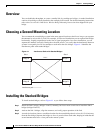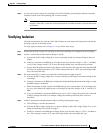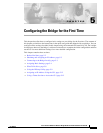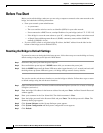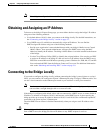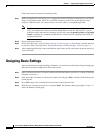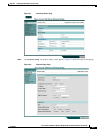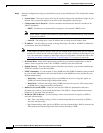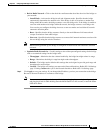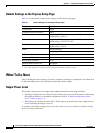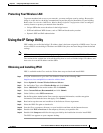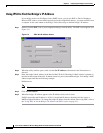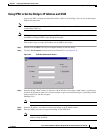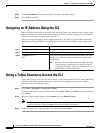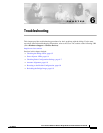
5-6
Cisco Aironet 1400 Series Wireless Bridge Hardware Installation Guide. OL-4072-03
OL-4072-04
Chapter 5 Configuring the Bridge for the First Time
Assigning Basic Settings
Step 6 Enter the configuration settings you obtained from your system administrator. The configurable settings
include:
• System Name—The system name, while not an essential setting, helps identify the bridge on your
network. The system name appears in the titles of the management system pages.
• Configuration Server Protocol—Click on the button that matches the network’s method of IP
address assignment.
–
DHCP—IP addresses are automatically assigned by your network’s DHCP server.
Note When DHCP is enabled, the IP Address, Subnet Mask, and Default Gateway fields indicate
Negotiated by DHCP
–
Static IP—The bridge uses a static IP address that you enter in the IP address field.
• IP Address—Use this setting to assign or change the bridge’s IP address. If DHCP is enabled for
your network, leave this field blank.
Note If the bridge’s IP address changes while you are configuring the bridge using the web-browser
interface or a Telnet session over the wired LAN, you lose your connection to the bridge. If you
lose your connection, reconnect to the bridge using its new IP address. Follow the steps in the
“Resetting the Bridge to Default Settings” section on page 5-2 if you need to start over.
• IP Subnet Mask—Enter the IP subnet mask provided by your network administrator so the IP
address can be recognized on the LAN. If DHCP is enabled, leave this field blank.
• Default Gateway—Enter the default gateway IP address provided by your network administrator.
If DHCP is enabled, leave this field blank.
• SNMP Community—If your network is using SNMP, enter the SNMP Community name provided
by your network administrator and select the attributes of the SNMP data (also provided by your
network administrator).
–
Read-Only—indicates the bridge allows only SNMP read accesses. Using this option, an
SNMP user cannot change bridge configuration settings.
–
Read-Write—indicates the bridge allows SNMP read and write accesses. This setting allows
an SNMP user to change the bridge configuration.
• Radio Service Set ID (SSID)—Enter the case-sensitive SSID (32 alphanumeric characters
maximum) provided by your network administrator. The SSID is a unique identifier that remote
bridges use to associate with your bridge.
• Broadcast SSID in Beacon—Use this setting to allow devices that do not specify an SSID to
associate with the bridge.
–
Yes—This is the default setting; it allows a remote bridge that does not specify an SSID to
associate with the bridge.
–
No—Remote bridges must specify an SSID to associate with the bridge. With No selected, the
SSID used by the remote bridge must match exactly the bridge’s SSID.



